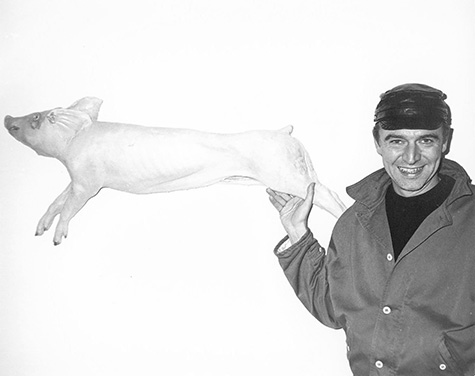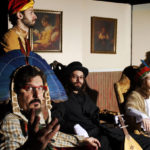In MemoriamThe Rene Ricard Story Goes Dark

Andy Warhol, Rene Ricard, n.d., ©The Andy Warhol Foundation for the Visual Arts, Inc.
“Boulevardier,” poet, critic, and painter, Rene Ricard was a somewhat reclusive yet significant figure in the cultural worlds of New York City. Andy Warhol referred to him in 1984 as “the George Sanders of the Lower East Side, the Rex Reed of the art world.” Most recently, Ricard’s paintings (his poems rendered in paint) were shown at Vito Schnabel’s Chelsea gallery in Manhattan in 2012.
On February 1st, Ricard’s life ended suddenly but, according to painter Brice Marden he was surrounded with friends at Bellevue Hospital, having been diagnosed with cancer after seeking hip-replacement surgery. His story begins with mystery; sources note that Ricard was born in Boston in 1946, but some admit that even this much is questionable.
According to a note written by Billy Name in an appointment book for the year 1968 which is held in The Warhol Museum’s archives, Rene Ricard may have been born on July 23. This interpretation isn’t entirely clear however, since the note states only “Rene Roger.” The suggestion of a birth date is due to the fact that each of Billy’s other entries in the same appointment book are individual’s birth dates and locations. Examples include “March 2, 1942 / 5 am Brooklyn / LOU REED,” and “August 6, 1928 / Pittsburgh / ANDY WARHOL,” and others including the recently departed Taylor Mead and Louis Waldon. This information was essential for Billy as he cast astrological charts for his friends. Jed Johnson also made notes in this book, indicating when Warhol was in Arizona shooting Lonesome Cowboys, and when the Factory moved from 47th Street to 33 Union Square West, and other practicalities.
In his book POP: The Genius of Andy Warhol, Tony Scherman writes that Rene was among the Harvard/Cambridge/Boston crowd that entered The Factory in 1965 (notably Edie Sedgwick, Ed “The Sugar Plum Fairy” Hood, Chuck Wein, Danny Fields, Danny Williams, and others). Ricard had a minor non-speaking role in Warhol’s film Kitchen (1965), washing dishes in the background as Roger Trudeau attempts to seduce Edie Sedgwick. The next year, Rene introduced teenage beauty Susan Bottomly to Warhol’s assistant Gerard Malanga, and she became known as International Velvet (being the Warhol equivalent of youthful Elizabeth Taylor’s role in National Velvet.) Ricard also appears in a reel of The Chelsea Girls, but due to Warhol’s instructions for how this double-screen film should be projected, his reel is silent in favor of that appearing at the right. According to Callie Angell, Ricard also appeared in six reels that were shot for Four Stars, the 25-hours-long film that consumed Warhol’s attention throughout 1967.
Rene Ricard’s notoriety in Warhol’s realm lies in his 1966 role in The Andy Warhol Story, an hour-long film that was never released. Little of the film is actually known to this day, though the two reels exist in the film collection of the Museum of Modern Art, but are not preserved. Published statements about it vary in the details (in interviews, Ricard himself wasn’t clear on where it was shot, either in his own apartment or Robert Arkin’s) but generally agree that Ricard portrayed Warhol in a vicious manner; Edie Sedgwick is also in the film, either also playing the role of Warhol, or that of someone abused by him. The story goes that the soundtrack was poorly recorded, either a series of beeps or recording only Sedgwick’s voice, rendering Ricard’s portrayal essentially silent.
Beyond his Warhol film days, yet still referencing them, Ricard acted in Underground U.S.A. (Eric Mitchell, 1980) which also included Factory-ites Taylor Mead and Jackie Curtis in the cast, along with then-current scene stars John Lurie, Patti Astor, and Cookie Mueller.
Among other citations, Rene Ricard’s poetry was published in Anne Waldman’s Angel Hair and George Plimpton’s The Paris Review. The Dia Art Foundation (one of three founding partners in the Warhol Museum) chose his work for their initial poetry publication, Rene Ricard 1979-1980. The marvelous series of Hanuman Books’ miniature editions included Ricard’s God With Revolver (1990). Along with fellow poets Robert Creeley, John Weiners and Michael McClure, Ricard read his poetry at an event at The Warhol in 1997, in conjunction with an exhibition of Francesco Clemente’s recent portraits of these poets as well as Allen Ginsberg and other figures from the New York scene.
The previous year, 1996, Ricard was himself portrayed in film, by Michael Wincott in Julian Schnabel’s directorial debut, Basquiat, starring Jeffrey Wright as Jean-Michel Basquiat, and David Bowie as Warhol.
One of Ricard’s best-known critical pieces for Artforum magazine is The Radiant Child, which announced the arrival of Basquiat as a new creative figure in the art world, in December 1981. In it, Ricard suggested through historical references (Pompeii, Socrates, and more) that not only was his work – and others of his generation, including Keith Haring, John Ahearn, Clemente, and Schnabel’s original guise as painter—new and bold, but also timeless, and maybe heroic. “Where is Taki?” Ricard repeated this graffiti phrase in his essay as poetic refrain, read also as it was seen incessantly in the personalized and fabulous subway cars of the day.
“Where is Taki?” To quote one of Ricard’s recent poem-paintings: “The V.I.P. room is closed.”
In the preface to his interview with Ricard in Vice magazine in 2009, Rocco Castoro noted of his subject: “In his criticism, Rene was one of those guys who saw things before anybody else did and who knew how to make people understand why what they were looking at was so damn important. That’s an essential role. That’s the kind of guy we all need.”
In the Vice interview, Ricard gave his thoughts on his chosen art form: “I loathe poetry. I just gave a poetry reading and other poets were standing up and reciting their rhymes from memory, I guess that’s cute, you know, with the backbeat, but I loathe it. I don’t like what I read in The New Yorker. I really like my own poetry a lot and I think that’s why I write it. Of all the arts, it’s the one I know the least about, and it’s interesting that it’s the one I practice and earn my living on. Anyway, yes, I like my own work. It speaks to me.”
Vice mag http://www.vice.com/read/fashion-hello-rene-ricard-886-v16n6
Dia book http://www.diabooks.org/item.m?itemID=19491
Basquiat review http://izharpatkin.com/Catalog_3.html

